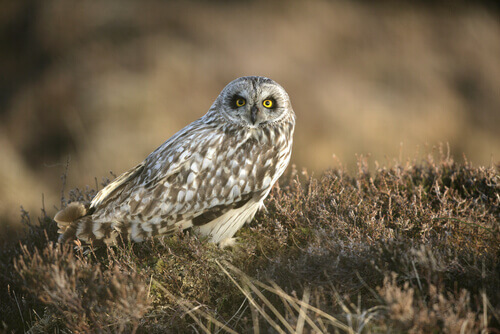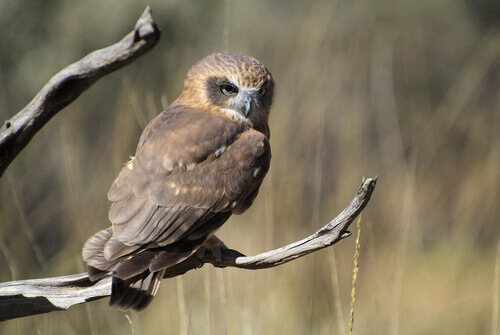Discover 5 Different Types of Owls

These birds of prey are known for their large eyes, heavily feathered heads, and nocturnal habits. In the following article, we want to tell you about 5 different types of owls that share certain characteristics. Keep reading to find out more.
What types of owls are there?
Owls are grouped into several families – titonidae is the most famous – and can be found almost everywhere in the world. They feed mostly on mice, although they also consume small insects, lizards, and bats. Learn about some of the most representative types of owls below:
1. The greater sooty owl (Tyto tenebricosa)
This species can be found in southeastern Australia and New Guinea, specifically in mountainous or coastal regions and tropical rain forests. It’s nocturnal, and sleeps during the day in caves among foliage or in tree hollows.
This owl, which appears at the top of this article – is about 18 inches long and weighs some 2.5 pounds (females are slightly larger and heavier). The plumage is dark gray with mottled white, and it has a heart-shaped facial disk, dark eyes, and feathered legs.
2. The barn owl (Tyto alba)
The barn owl is one of the most widely distributed birds in the world, with the exception of Canada, Greenland, Saharan Africa, and northern and central Asia. It’s about 14 inches long, but when flying it can reach a wingspan of 3 feet.

3. The boreal owl (Aegolius funereus)
Also known as Tengmalm’s owl, it inhabits central North America and Europe, specifically the Alps, the Pyrenees, and the Balkans. It lives in coniferous forests and never leaves the breeding area. It can nest at high altitudes, in holes in trees or in abandoned nests, where it lays up to 10 eggs between February and June.

4. The short-eared owl (Asio flammeus)
Although it’s a nocturnal bird, it’s one of the most diurnal owls. It can be seen in northwestern North America, southern South America, Europe, northern Africa, and northern and southern Asia, mainly in open areas, marshes, and coasts. It also migrates in winter to more temperate areas.

The plumage of the short-eared owl is brown, gray, and white. Its eyes are yellow and black and the wings are furrowed with a light stripe and black tips.
It nests on the ground, grass, or marshes and lays up to eight eggs, white in color, 48 hours apart. The female incubates for a little over a month and the male stands guard, in addition to providing food (voles and rodents).
5. The morepork (Ninox novaeseelandiae)
The last of the types of owls on our list inhabits Oceania, especially New Zealand. It prefers wooded habitats, dense tropical forests, grasslands, and even agricultural fields.

These birds of prey are known for their large eyes, heavily feathered heads, and nocturnal habits. In the following article, we want to tell you about 5 different types of owls that share certain characteristics. Keep reading to find out more.
What types of owls are there?
Owls are grouped into several families – titonidae is the most famous – and can be found almost everywhere in the world. They feed mostly on mice, although they also consume small insects, lizards, and bats. Learn about some of the most representative types of owls below:
1. The greater sooty owl (Tyto tenebricosa)
This species can be found in southeastern Australia and New Guinea, specifically in mountainous or coastal regions and tropical rain forests. It’s nocturnal, and sleeps during the day in caves among foliage or in tree hollows.
This owl, which appears at the top of this article – is about 18 inches long and weighs some 2.5 pounds (females are slightly larger and heavier). The plumage is dark gray with mottled white, and it has a heart-shaped facial disk, dark eyes, and feathered legs.
2. The barn owl (Tyto alba)
The barn owl is one of the most widely distributed birds in the world, with the exception of Canada, Greenland, Saharan Africa, and northern and central Asia. It’s about 14 inches long, but when flying it can reach a wingspan of 3 feet.

3. The boreal owl (Aegolius funereus)
Also known as Tengmalm’s owl, it inhabits central North America and Europe, specifically the Alps, the Pyrenees, and the Balkans. It lives in coniferous forests and never leaves the breeding area. It can nest at high altitudes, in holes in trees or in abandoned nests, where it lays up to 10 eggs between February and June.

4. The short-eared owl (Asio flammeus)
Although it’s a nocturnal bird, it’s one of the most diurnal owls. It can be seen in northwestern North America, southern South America, Europe, northern Africa, and northern and southern Asia, mainly in open areas, marshes, and coasts. It also migrates in winter to more temperate areas.

The plumage of the short-eared owl is brown, gray, and white. Its eyes are yellow and black and the wings are furrowed with a light stripe and black tips.
It nests on the ground, grass, or marshes and lays up to eight eggs, white in color, 48 hours apart. The female incubates for a little over a month and the male stands guard, in addition to providing food (voles and rodents).
5. The morepork (Ninox novaeseelandiae)
The last of the types of owls on our list inhabits Oceania, especially New Zealand. It prefers wooded habitats, dense tropical forests, grasslands, and even agricultural fields.

This text is provided for informational purposes only and does not replace consultation with a professional. If in doubt, consult your specialist.








